Common menu bar links
Institutional links
Diseases & Conditions
Health & Safety
Research & Statistics
Agency Information
Search Box
E-mail this page
Tuberculosis in Canada 1998
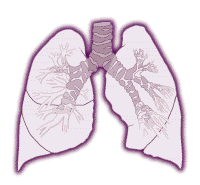
|
|
|
|
|
|
| FIGURES
|
|
|
Reported new active and relapsed tuberculosis incidence rate per 100,000 - Canada: 1924-1998 |
|
|
Reported new active and relapsed tuberculosis cases and incidence rate per 100,000 - Canada: 1980-1998 |
|
|
Reported new active and relapsed tuberculosis incidence rate per 100,000 by age group - Canada: 1983-1998 |
|
|
Distribution of reported new active and relapsed tuberculosis cases by origin - Canada: 1980 and 1998 |
|
|
Reported new active and relapsed tuberculosis incidence rate per 100,000 by main diagnostic site - Canada: 1988-1998 |
|
|
Distribution of reported new active and relapsed tuberculosis cases and incidence rate per 100,000 by origin - provinces/territories: 1998 |
|
|
Reported new active and relapsed tuberculosis cases by age group and origin - Canada: 1998 |
|
|
Distribution of reported new active and relapsed tuberculosis cases by origin and main diagnostic site - Canada: 1998 |
|
| TABLES
|
|
|
Table 1A |
Reported new active and relapsed tuberculosis cases and incidence rate per 100,000 - Canada and provinces/territories: 1988-1998 |
|
Table 1B |
Reported new active tuberculosis cases and incidence rate per 100,000 - Canada and provinces/territories: 1988-1998 |
|
Table 1C |
Reported relapsed tuberculosis cases and incidence rate per 100,000 - Canada and provinces/territories: 1988-1998 |
|
Table 2A |
Reported new active and relapsed tuberculosis cases and incidence rate per 100,000 by age group - Canada: 1988-1998 |
|
Table 2B |
Reported new active and relapsed tuberculosis cases and incidence rate per 100,000 by age group - males - Canada: 1988-1998 |
|
Table 2C |
Reported new active and relapsed tuberculosis cases and incidence rate per 100,000 by age group - females - Canada: 1988-1998 |
|
Table 3 |
Reported new active and relapsed tuberculosis cases by birthplace - Canada: 1988-1998 |
|
Table 4 |
Reported new active and relapsed tuberculosis cases and incidence rate per 100,000 by main diagnostic site - Canada: 1988-1998 |
|
Table 5A |
Reported new active and relapsed tuberculosis cases and incidence rate per 100,000 by age group - Canada and provinces/territories: 1998 |
|
Table 5B |
Reported new active and relapsed tuberculosis cases and incidence rate per 100,000 by age group - males - Canada and provinces/territories: 1998 |
|
Table 5C |
Reported new active and relapsed tuberculosis cases and incidence rate per 100,000 by age group - females - Canada and provinces/territories: 1998 |
|
Table 6 |
Reported new active and relapsed tuberculosis cases and incidence rate per 100,000 by birthplace - Canada and provinces/territories: 1998 |
|
Table 7 |
Reported new active and relapsed tuberculosis cases and incidence rate per 100,000 by main diagnostic site - Canada and provinces/territories: 1998 |
|
Table 8 |
Reported new active and relapsed tuberculosis cases by birthplace, gender and age group - Canada: 1998 |
|
Table 9 |
Reported new active and relapsed tuberculosis cases and incidence rate per 100,000 by age group and main diagnostic site - Canada: 1998 |
|
Table 10 |
Reported new active and relapsed tuberculosis cases by birthplace and main diagnostic site - Canada: 1998 |
|
Table 11 |
Reported new active and relapsed tuberculosis cases by birthplace and activity status - Canada: 1998 |
|
Table 12 |
Reported new active and relapsed tuberculosis cases by bacillary status - Canada and provinces/territories: 1998 |
|
Table 13 |
Reported new active and relapsed tuberculosis cases by bacillary status and birthplace - Canada: 1998 |
|
Table 14 |
Reported new active and relapsed tuberculosis cases by bacillary status and main diagnostic site - Canada: 1998 |
|
Table 15 |
Pattern of reported drug resistance to first-line anti-tuberculosis drugs at time of reporting - Canada and provinces/territories: 1998 |
|
Table 16 |
Pattern of reported drug resistance to first-line anti-tuberculosis drugs at time of reporting by birthplace - Canada: 1998 |
|
Table 17 |
Reported new active and relapsed tuberculosis cases by method of detection - Canada and provinces/territories: 1998 |
|
Table 18 |
Reported new active and relapsed tuberculosis cases by method of detection and birthplace - Canada: 1998 |
|
Table 19 |
Reported new active and relapsed foreign-born tuberculosis cases by birthplace and year of arrival in Canada: 1998 |
|
Table 20 |
Reported new active and relapsed foreign-born tuberculosis cases by immigration status - Canada and provinces/territories: 1998 |
|
Table 21 |
Reported relapsed tuberculosis cases by length of inactive interval - Canada and provinces/territories: 1998 |
|
Table 22 |
Reported new active and relapsed tuberculosis cases and number of diagnoses by main diagnostic site - Canada: 1998 |
|
Table 23 |
Reported new active and relapsed tuberculosis cases reported in 1998 who died in 1998, by cause of death - Canada and provinces/territories: 1998 |
|
Table 24 |
Reported new active and relapsed tuberculosis cases reported in 1998 who died in 1998, by age group and gender - Canada: 1998 |
|
Table 25 |
Reported new active and relapsed tuberculosis cases by HIV status - Canada and provinces/territories: 1998 |
|
APPENDICES |
|
|
Appendix 1A |
Population estimates by gender and age group - Canada and provinces/territories: 1998 |
|
Appendix 1B |
Population estimates by Canadian-born origin and foreign-born birthplace - Canada and provinces/territories: 1998 |
|
Appendix 2 |
Active Tuberculosis Report Form - New and Relapsed Cases |
|
Appendix 3 |
Technical Notes |
INTRODUCTION
The 1998 Tuberculosis in Canada annual report is a publication of Tuberculosis Prevention and Control (TBPC), Centre for Infectious Disease Prevention and Control, Public Health Agency of Canada, Health Canada. Reports of new active and relapsed tuberculosis cases are reported to TBPC through the Canadian Tuberculosis Reporting System (CTBRS) from the ten provinces and two territories.
This publication is similar to previous annual reports published by TBPC and presents summary data for cases reported to the CTBRS which were diagnosed in 1998. The report contains information on the overall TB case counts and case rates for selected demographic and clinical characteristics. Presented in the report are data on the following characteristics:
- age
- gender
- province/territory
- birthplace
- activity status
- main diagnostic site
- bacillary status
- pattern of drug resistance
- method of detection
- immigration status
- HIV status.
The increased proportion of tuberculosis in foreign-born individuals is reflected in the tables wherein the birthplace (grouped by World Health Organization (WHO) region) is presented as a variable (Tables 3, 6, 8, 10, 11, 13, 16, 18, 19, 20).
As a result of a review of the national tuberculosis surveillance system conducted jointly in 1997 by the Canadian Tuberculosis Committee and TBPC, two previously included tables have been excluded from the report. No longer included are:
- Reported new active and relapsed tuberculosis
cases by bacillary status and main diagnostic site - Canada and
provinces/territories; and,
- Reported new active and relapsed tuberculosis cases by birthplace and bacillary status - Canada and provinces/territories.
Two new tables have been added that present data items on the pattern of drug resistance (at time of reporting) to first line anti-tuberculosis drugs for TB cases diagnosed in 1998 (Tables 15 and 16). Furthermore, changes in the order of presentation of Tables 12, 13 and 14 have been made. Reported new active and relapsed tuberculosis cases by bacillary status and other selected characteristics are now reported with the culture status first, followed by the microscopy status.
Appendices to the report include population estimates for 1998 (Appendices 1A, 1B), the tuberculosis reporting form (Appendix 2) and technical notes on the methodology of the report including the definition of terms (Appendix 3).
The annual reports on tuberculosis morbidity have undergone and will continue to have revisions in format and content from year to year. It is our goal to continue to adapt and improve this publication in response to changes in the epidemiology and treatment of tuberculosis. We welcome any comments on the content or format of this document.
EXECUTIVE SUMMARY
In 1998, a total of 1,796 cases (5.9 per 100,000) of new active and relapsed tuberculosis (TB) were reported to Tuberculosis Prevention and Control from the ten provinces and two territories. This number represents a decrease of 9% from 1997 (6.6 per 100,000) and is the lowest number of reported cases in the last two decades. New active cases made up the vast majority (90%) of reported cases with relapsed cases accounting for the remainder.
Six of the reporting jurisdictions had case rates below the national rate (Alberta, New Brunswick, Newfoundland, Nova Scotia, Prince Edward Island and Quebec). The three most populous provinces (Ontario, Quebec and British Columbia) which collectively make up 75% of Canada's population, also accounted for 75% of the total number of reported cases. Compared with the previous year, seven reporting jurisdictions (Alberta, British Columbia, Newfoundland, Ontario, Prince Edward Island, Quebec and Saskatchewan) reported a decrease in case numbers and rates. Slightly increased rates were reported for Manitoba, New Brunswick, the Northwest Territories and Nova Scotia. There was no change for the Yukon Territory (Table 1A).
Trends with respect to TB incidence and birthplace continue to indicate the highest burden of disease among the foreign-born population. From 1988 to 1998, the number of cases among Canadian-born non-Aboriginal individuals decreased by 52% (724 to 348 cases), while that among Canadian-born Aboriginal people decreased by 16% (332 to 278 cases). During the same time period, the number of cases among foreign-born persons increased by 33% (891 to 1,154 cases). Of note, however, is that the most dramatic decrease in TB cases reported for 1998 occurred in the foreign-born population with the total number of cases falling from 1,271 in 1997 to 1,154 in 1998 (Table 3). The proportions of all TB cases that were Canadian-born non-Aboriginal, Canadian-born Aboriginal and foreign-born in 1988 were, 37%, 17% and 46% respectively. By 1998, these proportions had decreased among Canadian-born non-Aboriginal and Canadian-born Aboriginal people to 19% and 15% respectively, whereas among the foreign-born the proportion had increased to 64%.
With regard to the distribution of cases by birthplace across the country in 1998, the provinces of British Columbia and Ontario reported the highest percentage of foreign-born cases (71% and 83% respectively). In other jurisdictions foreign-born cases accounted for over half of all reported cases (Alberta 59%; Quebec 56%). In the Northwest Territories, Saskatchewan and Manitoba, cases among Canadian-born Aboriginal people contributed all or a large percentage of reported cases (Northwest Territories 100%; Saskatchewan 85%; Manitoba 43%) (Table 3).
By age group, individuals aged 25 to 34 years made up the largest number of reported cases, accounting for 17% of the total. However, the corresponding case rate of 6.7 per 100,000 for this age group was surpassed by the age-specific rates of 11.1 and 16.1 per 100,000 for those in the older age groups of 65 to 74 and greater than 74 years respectively (Table 2A). Canadian-born non-Aboriginal cases were relatively older (median 58 years) than foreign-born (median 41 years) and Canadian-born Aboriginal TB cases (median 30 years).
The presentation of tuberculosis by gender revealed a larger number of reported cases among males (968 cases, 6.4 per 100,000) than among females (828 cases, 5.4 per 100,000) (Tables 2B, 2C).
Overall, respiratory TB (see Technical Notes for definition) was the main diagnostic site, representing 64% of reported cases in 1998 (Table 4). A larger proportion of Canadian-born non-Aboriginal cases were reported as respiratory TB (75%) compared with that among both the Canadian-born Aboriginal and foreign-born cases (56% and 63% respectively). TB of the peripheral lymph nodes was the second most commonly reported diagnostic site, with almost half of all such cases occurring in foreign-born individuals who originated in the WHO Western Pacific Region. Among the Canadian-born Aboriginal cases, primary TB accounted for the most significant proportion (26%) of all notifications after respiratory TB (Table 10).
A total of 1,597 of the 1,796 reported cases (89%) were laboratory confirmed. Of the 1,152 respiratory cases, 54% were smear (microscopy) positive and 85% were culture positive (Table 14).
The majority of reported cases (74%) were detected through presentation of symptoms to a medical professional (Table 17).
Of the 1,796 cases diagnosed in 1998, 122 were reported to have died in the same year. TB was reported as the underlying cause of death for 19 cases (16%). For 54 cases (44%), TB was reported as contributing to death, but not as the underlying cause (Table 23). It should be noted that the number of reported TB related deaths is an underestimate, as it includes only known deaths occurring in the same year as the diagnosis at the time of reporting.
In recognition of the important interaction between TB and HIV infection, collection of HIV status began in 1997. The analysis of this variable indicated that HIV status was unknown for 92% of reported cases (Table 25). Further collaborative efforts with each of the provincial and territorial TB control and HIV/AIDS programs is necessary to gain a better understanding of the extent of TB/HIV co-infection in Canada.
FIGURES
Figure 1
Reported new active and relapsed tuberculosis incidence rate per
100,000 - Canada: 1924-1998

Figure 2
Reported new active and relapsed tuberculosis cases and incidence
rate per 100,000 - Canada: 1980-1998

Figure 3
Reported new active and relapsed tuberculosis incidence rate per
100,000 by age group - Canada: 1983-1998

Figure 4
Distribution of reported new active and relapsed tuberculosis cases
by origin - Canada: 1980 and 1998
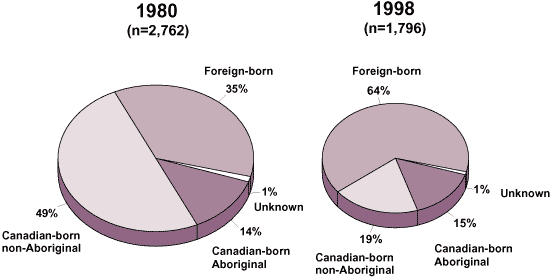
Figure 5
Reported new active and relapsed tuberculosis incidence rate per
100,000 by main diagnostic site - Canada: 1988-1998
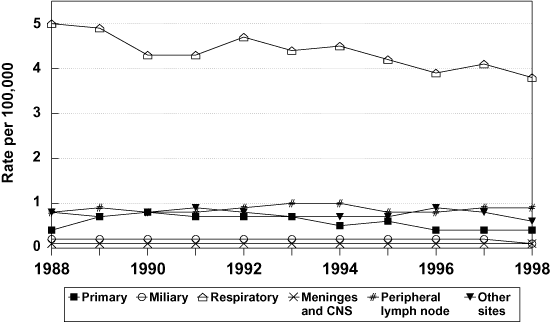
Figure 6
Distribution of reported new active and relapsed tuberculosis cases
and incidence rate per 100,000 by origin - provinces/territories:
1998 (n=1,796)
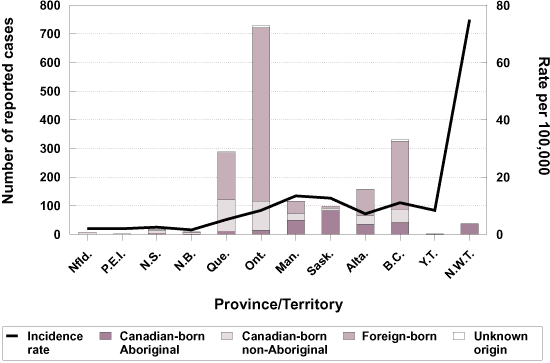
Figure 7
Reported new active and relapsed tuberculosis cases by age group
and origin - Canada: 1998 (n=1,796)
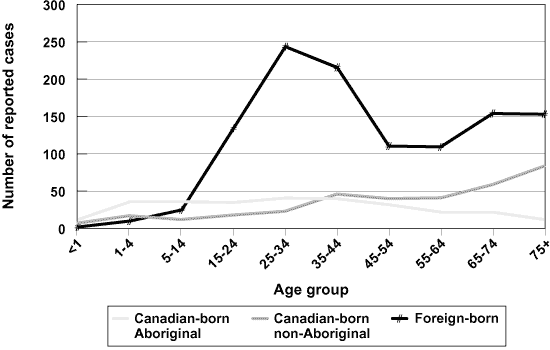
Figure 8
Distribution of reported new active and relapsed tuberculosis cases
by origin and main diagnostic site - Canada: 1998
(n=1,796)
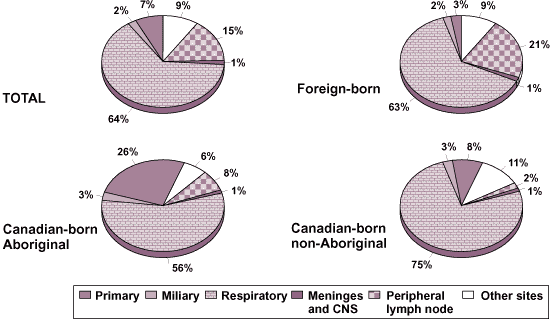
HOW TO REACH US
For more information, copies of this report or other related reports, please contact:
Tuberculosis
Prevention and Control
Centre for
Infectious Disease Prevention and Control
Public Health
Agency of Canada
Health Canada
Room 0108B, Brooke
Claxton Building
Tunney's
Pasture, Ottawa, Ontario K1A 0K9
Internal Postal Address: 0900B-1
Telephone:
(613) 941-0238
Facsimile:
(613) 946-3902
The following figures, tables and explanatory text were prepared by:
Penny
Nault
Tuberculosis
Database Manager
Tuberculosis
Prevention and Control
Melissa
Phypers, MSc
Acting Chief
Tuberculosis
Prevention and Control
ACKNOWLEDGEMENT
The authors would like to acknowledge the Provincial/Territorial Tuberculosis Programs and their teams for their contribution to and participation in the Canadian Tuberculosis Reporting System (CTBRS).
The authors would also like to thank the Scientific Publication and Multimedia Services Unit, Public Health Agency of Canada, for its assistance in preparing this report.
Published by authority of the Minister of Health
© Minister of Public Works and Government Services Canada 2002
This publication can be made available in alternative formats upon request.
